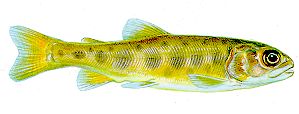
The Trout's Life Cycle

|
A sea
trout smolt. This specimen was taken from the headwaters of a
river that cannot be reached by sea trout: its parents were river
brown trout whose genes resulted in some of their progeny becoming
sea trout. |
All trout are born in freshwater, usually in flowing river water or in a lake close to a feeder or outflow stream. Trout eggs cannot develop in sea-water and they require a good through-flow of oxygenated water if they are to develop. After a period of 30 or more days, depending on water temperature, the eggs hatch into alevins, embryonic fish that retain the remains of the yolk sac and continue to live deep in the gravel redd. Once the supply of yolk has been exhausted the alevin becomes a fry, and swims up through the gravel and starts to feed.
The tiny fry grows quickly and soon begins to attain the appearance of a trout, but with ovoid markings down its sides. These markings, known as parr-markings, give the name parr ' to the young trout stage. The word parr derives from the Old English word for finger: such small trout are sometimes known as 'fingerlings' and the parr marks as 'fingermarks'. How long the trout remains as a parr depends to a large extent on the amount of food in the water: it may be anything from one year to four years. At this stage, sea-going varieties of trout assume silver coats and head downstream. They are then known as 'smolts'. Trout that spend their entire lives in freshwater assume adult coloration without going through the smolt stage.

|
A trout
fry with its parr marks developing. Some weeks after the young
trout fry finally exhausts the food supply of its own original
egg yolk, it acquires a series of oval markings along the body.
When these markings are fully developed then the fry will be a
parr. |
Trout come into breeding condition at any age from three years upward and then embark on what, for the non-river varieties, can be the hazardous journey to the spawning grounds. Those that feed in shoals - the sea-going trout and many lake forms - make their runs up the river in loose shoals. In many cases, these trout either do not feed at all or else take in very little food while they are in the river. They must therefore survive the journey on the food reserves they have built up on their feeding grounds: reserves of oil and protein in their muscles. By contrast, river trout, which tend to be solitary feeders, remain solitary as they move to the spawning grounds. They make their way slowly, stopping at intervals to take up 'lies' in the river and feed.
The trout adopt their mates in the spawning areas, usually shallow water flowing over pea-sized gravel. With a sweep of the tail, the females cut channels known as redds in the gravel and deposit the eggs, which the male fertilizes with 'milt' before covering up the redd. Once spawning is completed the trout (now known as 'kelts') move quickly downstream, often in poor physical condition and considerably darker in colour. For sea trout, the journey may take several weeks and, though some kelts may take some food, mortality is high. Lake trout, too, may be severely weakened; but many varieties of river trout will resume feeding normally as soon as breeding is completed. They will even devour the eggs of other trout and salmon that have been washed from the redds.